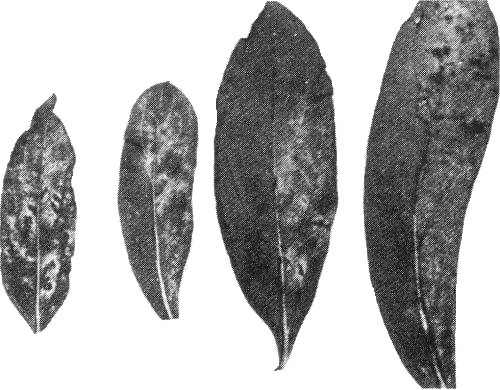Details of DPV and References
DPV NO: 97 October 1972
Family: Potyviridae
Genus: Potyvirus
Species: Pokeweed mosaic virus | Acronym: PkMV
Pokeweed mosaic virus
R. J. Shepherd Department of Plant Pathology, University of California, Davis, California 95616, USA
Contents
- Introduction
- Main Diseases
- Geographical Distribution
- Host Range and Symptomatology
- Strains
- Transmission by Vectors
- Transmission through Seed
- Transmission by Grafting
- Transmission by Dodder
- Serology
- Nucleic Acid Hybridization
- Relationships
- Stability in Sap
- Purification
- Properties of Particles
- Particle Structure
- Particle Composition
- Properties of Infective Nucleic Acid
- Molecular Structure
- Genome Properties
- Satellite
- Relations with Cells and Tissues
- Ecology and Control
- Notes
- Acknowledgements
- Figures
- References
Introduction
- Described by Woods (1902) and Allard (1918).
- Synonym
- Phytolacca decandra
mosaic virus (Rev. appl. Mycol. 5: 314).- A virus with elongated, flexuous particles averaging about 776 nm in length. It has a restricted host range, is transmitted by aphids in a non-persistent manner, and readily by inoculation with plant extracts. It is widespread in North America.
- Synonym
Main Diseases
Causes a mosaic and mottle disease of pokeweed, Phytolacca americana.
Geographical Distribution
Widely distributed in North America east of the Rocky Mountains.
Host Range and Symptomatology
Host range is restricted; only 3 species of higher plants have been infected experimentally. The virus is readily transmissible with plant extracts from pokeweed to pokeweed; pokeweed, however, contains a potent inhibitor of infection which may prevent mechanical transmission of the virus to unrelated species (Duggar & Armstrong, 1925; Kassanis & Kleczkowski, 1948). Aphids are useful for transmitting the virus from pokeweed to other hosts (Shepherd, Fulton & Wakeman, 1969).
- Diagnostic species
- Phytolacca americana
(pokeweed, or pokeberry). No local symptoms may be induced. Systemic symptoms consist of pronounced chlorotic mottle or mosaic with conspicuous dark green islands (Fig. 1). Large green islands are usually accompanied by puckering. - Gomphrena globosa. Feathery chlorotic mottle or faint generalized
chlorosis with small necrotic spots on some leaves (Fig. 2).
- Chenopodium quinoa. Small chlorotic local lesions. Not systemic.
- Propagation species
- Pokeweed is a suitable host for maintaining cultures and for propagating virus for purification.
- Assay species
- Chenopodium quinoa
is a suitable local lesion host for bioassay of some isolates of the virus.
Strains
Variants have not been distinguished or described.
Transmission by Vectors
The virus is transmitted in a non-persistent manner by aphids as shown by tests with Myzus persicae. Can be acquired and inoculated in 1-2 min. No latent period. Retained for 1-3 hr.
Transmission through Seed
The virus is not seed-borne in pokeweed.
Serology
The virus is a potent antigen in rabbits. Tube or micro-precipitin tests with clarified sap or partially purified virus preparations are the most useful because the virus does not diffuse well in agar gels. Intact virus particles give flagellar-type precipitates in tube tests.
Relationships
The virus may be distantly related serologically to tobacco etch, henbane mosaic and potato Y viruses as shown by tests with broad-spectrum antisera (Shepherd et al., 1969).
Stability in Sap
In sap from systemically infected pokeweed plants 3 weeks after inoculation: thermal inactivation point (10 min), 70-75°C; longevity (c. 25°C), 10 days; dilution end-point, 10-5-10-6.
Purification
Homogenize infected pokeweed tissue in 0.5 M borate, pH 8.2, containing 0.5% thioglycollic acid. Clarify by emulsifying with one-third volume chloroform and recovering the aqueous phase after low speed centrifugation. Ultracentrifuge the clarified extract for 2 hr at 30,000 rev/min and resuspend the pellets in 0.02 M borate, pH 8.2. Preparations can be further purified by (a) adjusting solutions to pH 5.0, followed by low speed centrifugation to remove impurities, and dialysis of the supernatant fluid against 0.02 M borate, pH 8.2, or (b) passing partially purified virus through a column of agarose heads (Bio-gel A-150 M, Bio-Rad Laboratories, Richmond, Calif.) equilibrated with 0.01 M borate, pH 8.2.
Properties of Particles
No information.
Particle Structure
Particles are slightly flexuous filaments (Fig. 3) of diameter 12-13 nm and modal length about 776 nm (Shepherd et al., 1969).
Relations with Cells and Tissues
The virus induces ‘pinwheel’ inclusions in the cytoplasm of infected cells similar to those associated with potato virus Y group viruses (see Edwardson, 1966; Edwardson, Purcifull & Christie, 1968). Finely striated inclusions, which are probably derived from pinwheel bodies in the cell, are numerous in negatively stained leaf extracts.
Figures
References list for DPV: Pokeweed mosaic virus (97)
- Allard, Phytopathology 8: 51, 1918.
- Duggar & Armstrong, Ann. Mo. bot. Gdn 12: 359, 1925.
- Edwardson, Am. J. Bot. 53: 359, 1966.
- Edwardson, Purcifull & Christie, Virology 34: 250, 1968.
- Kassanis & Kleczkowski, J. gen. Microbiol. 2: 143, 1948.
- Shepherd, Fulton & Wakeman, Phytopathology 59: 219, 1969.
- Woods, Bull. Bur. Pl. Ind. U.S. Dep. Agric. 18, 24 pp., 1902.


